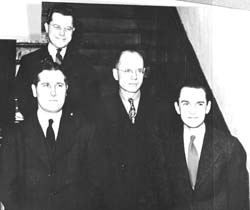
|
Pages: << Back 1 2 3 4 5 6 7 8 9 10 Next >> The exterior of Mason Hall followed a very similar pattern, but with the front entrance on Anderson Street made conspicuous by tall classical columns on a semicircular portico looking out over a broad expanse of lawn. In the rear it abutted the quadrangle formed with Rector and Lucy Rowland Halls, with arched windows and entryways designed to harmonize with those of the latter building standing opposite it. The general effect inside the residential quadrangle was of a blending, rather than a clashing, of the Colonial Revival lines of Mason Hall with the more eclectic design of the older halls. Besides rooms for more than 100 women, Mason contained a spacious dining hall and an elegant lobby from the ceiling of which hung an elaborate glass chandelier imported from Czechoslovakia. Historian George Manhart has testified that it was long considered the "show place of the campus." In
1938 the heirs of Robert L. and Eva H. O'Hair of Greencastle donated
the large family residence on Seminary Street to the university.
For a time this handsome red-brick structure was under consideration
as the site of a possible faculty club but instead was turned over
to the university health services to provide much-needed enlargement
of its facilities. By 1940 O'Hair House was remodeled into an infirmary,
with a physician's office, X-ray room, laboratory, diet kitchen,
and a few beds for student patients. At the same time the university
engaged the services of its first fu11-time physician, Dr.
George F. Parker, who operated the infirmary with the assistance
of long-time staff member Kathryn Davenport and other nurses.
Another important addition to the physical plant was the construction of a permanent stadium in 1941 to replace the wooden bleachers at Blackstock Athletic Field. The gift of Mary H. Blackstock, who continued to show an active interest in her husband's alma mater long after his death, the stadium was built to seat approximately 4,000 persons and contained an enclosed press box as well as commodious dressing rooms for both home and visiting teams. Mrs. Blackstock later became the first woman elected to the DePauw board of trustees.
The
early years of the Wildman administration brought some shifts in
administrative personnel. In 1936 the formidable dean of women,
Katherine Alvord, retired and was replaced
by her assistant, Helen C. Salzer, who served until 1943. Wildman
strengthened and expanded the office of academic dean, assigning
to it some of the duties formerly handled by the president himself.
The incumbent, William Blanchard, was encouraged to give up his
teaching responsibilities in the department of chemistry in order
to devote himself fully to the supervision of the entire academic
program as well as the work of the registrar's office, the library,
and the recently integrated Music School. Upon Blanchard's resignation
in 1941 after suffering a severe heart attack, the president named
to that post a fellow Boston University alumnus, Edward R. Bartlett,
who had organized and led the department of religious education
since 1923.
President
Wildman faced a difficult personnel question in the case of Comptroller
Ralph Schenck, whose handling of university business affairs had
come under severe criticism from the faculty. In early 1941, a special
faculty committee investigated the charges against him and brought
its findings, largely unfavorable, to the attention of the president
and the trustees. Schenck submitted his resignation as comptroller
along with a bill for his services in connection with the design
and construction of Mason and Harrison Halls. The board of trustees
eventually settled with him for half the amount of money he had
requested. In his place the president appointed Howell H. Brooks
comptroller and M. Arthur Perry superintendent of buildings and
grounds.
New appointments were made to the teaching faculty, helping to fill out to some degree the ranks depleted by the reduction of the early years of the depression. They included Wisner Kinne, Paul J. Carter, William H. Strain, and Frederick L. Bergmann in English, the last of whom also served for a time as director of publicity for the university; Gerald E. Warren and Carl W. McGuire in economics; Harriet M. Hazinski in art; Lester B. Sands in education; Vernon Van Dyke in political science; Harry J. Skornia and George F. Totten in speech; Joseph C. Heston in psychology; D. Keith Andrews in English Bible; Howard R. Youse in botany; Walter E. Martin in zoology; Jonathan S. Lee in physics; Milton C. Kloetzel in chemistry; Mary E. Smith in mathematics; James Y. Causey and Julia Crawley (Shumaker) in Romance languages; and Helen J. Cade in home economics. In 1937 Van Denman Thompson, professor of piano and organ as well as university organist, succeeded Dean Robert McCutcheon as director of the School of Music, a new title selected as more in accord with the new status of that institution. Added to the corps of music instructors were C. Edmond Jarvis in voice and Howard B. Waltz and Helen Harrod (Perry) in piano.
___________________________________ |
Depauw University e-history | E-mail comments to: archives@depauw.edu

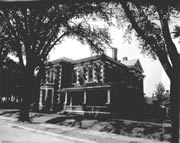
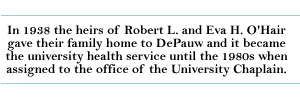

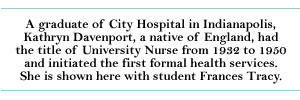
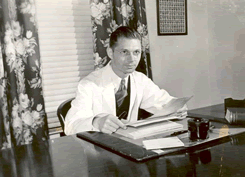
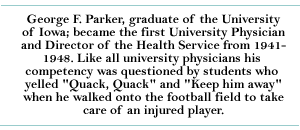
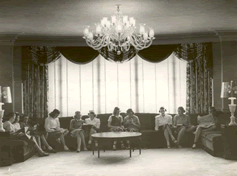

 _______________________________________
_______________________________________